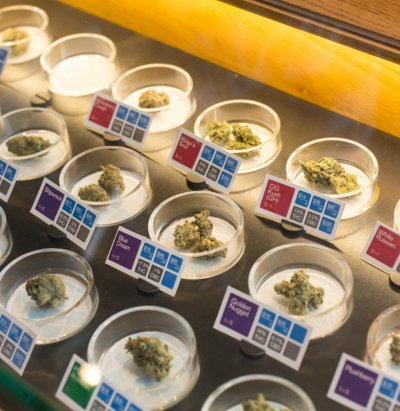
Cannabis buds with potency testing results on display at a dispensary. (Photo: Sonya Yruel/Drug Policy Alliance.)
ANNAPOLIS (Oct. 21, 2014)—After Maryland is given the OK from the federal government, patients will be able to walk into a dispensary, show their card to the retailer and pick up their medical marijuana prescription.
But before medicinal cannabis ever changes hands from retailer to consumer, it has already been through an extensive trek.
There is a complex process between the time a marijuana seed is planted and when the consumer picks up a prescription at the counter.
That whole intermediate process is one of the factors delaying Maryland’s implementation of medical marijuana.
Maryland’s Medical Marijuana Commission
The crowd at the state’s medical marijuana commission meetings in Annapolis on Sept. 9 and Sept. 23 consisted mostly of growers, dispensers and consulting firm representatives who were eager to join the new program. Since September 2013, the 15-member commission has held 15 meetings to discuss details about Maryland’s future medical cannabis industry.
Dispensers, growers and patients in need of medicinal marijuana are growing more and more restless with each passing commission meeting.
Distribution of medical marijuana in Maryland is not expected to start until early 2016.
“I can see recreational marijuana being legalized before medical marijuana is finalized in Maryland,” said Judy Pentz, executive director of the state chapter of NORML (National Organization for the Reform of Marijuana Laws). “The commission seems stuck in the reefer madness era.”
Sharon Bloom, executive director of the commission, said the wait is for a valid reason.
“There are no obstacles blocking us, only a regulatory process that needs to be followed and the informal process prior,” Bloom said. The commission is still working on the “informal process” of getting Maryland’s medical marijuana industry plans and regulations straightened out before they are sent to the federal government.
“If we do a job that the (U.S.) attorney general and the (Drug Enforcement Agency) reject, we’re back to ground zero,” said Eric Sterling, a member of the commission and a lawyer with over 30 years of experience working on medical marijuana issues.
Maryland is one of 23 states in which medical marijuana is legal.
According to the commission’s latest draft of regulations, grower application fees in Maryland are not to exceed $6,000, but annual license fees for growers are $125,000. Licensing fees for dispensaries are $40,000 a year.
In Colorado, the application fees for dispensaries can be as high as $15,000, depending on what type of distributor it is. Licensing fees can cost up to $13,200.
In Washington state, marijuana producers must pay an annual fee of $1,000 and a $250 application fee. Retailers must pay the same fees.
Though a few members of the commission admitted Maryland’s fees seem high, especially for small businesses, Bloom maintained they are not negotiable.
“We need to have the money to support our program,” Bloom said. “These fees are in line with other states with a similar number of dispensers. We were given a rather limited budget and we’re doing the best we can.”
The commission is working with a $745,700 budget for the current fiscal year, according to legislative services. This budget does not include any revenue from dispensaries, as none have opened yet.
Maryland plans to implement a sales tax on medical marijuana, but the exact percentage has yet to be determined.
The commission anticipates 44 operating dispensaries in Maryland once the program is up and running.
Cannabis Cultivation
Depending on the state, the marijuana seed or cutting could start out in farm soil or in a greenhouse or a highly secured warehouse.
Cloning is a method of breeding plants by cutting and rooting a healthy shoot. A clone has one parent and is genetically identical to it. The donor plant is known as a “mother plant.”
Growers use the cloning method for a variety of reasons, according to Kris Hermes, the media specialist at Americans for Safe Access, a medical marijuana advocacy group based in California and Washington, D.C.
Firstly, it ensures the gender of the plant, which is “immensely important,” Hermes said.
Growers prefer unpollenated female plants because they produce the most potent “smokeable buds” filled with Tetrahydrocannabinol, or THC, the principal chemical in cannabis that makes users feel high. Male plants produce no buds and minimal THC, according to Hermes.
Cloning also enables growers to easily produce “large quantities of new plants,” Hermes said.
Cuttings or clones usually cost between $6 and $15 apiece, according to Ben Holmes, an experienced cannabis cultivator and founder of Centennial Seeds in Denver.
Far fewer cultivators use seeds now than in previous years, with the exception of those who are trying to create hybrid strains, according to Hermes. These hybrids are combinations of different strains, catered to the specific symptoms of patients. Certain strains, such as Charlotte’s Web, contain more THC than others and are more effective medicinally, according to Hermes.
Holmes urges growers to buy seeds instead of cuttings, due to what he calls “inherent problems” with indoor growing. He charges about $5.25 per seed.
“You don’t have to worry about mites
Holmes said there is an underground community of breeders who were instrumental in bringing seeds to the U.S. In the mid-1990s, these breeders sold these seeds to growers in Amsterdam, Canada, Spain and the United Kingdom. Over time, growers in Europe and Canada then sold those seeds back into the U.S, even though importing seeds has long been banned.
“Customs has stepped up their enforcement over the years,” Holmes said. “People will often try to import seeds and customs end up (intercepting) and seizing them.”
Holmes said he believes the seed industry will take off as marijuana laws loosen up across the country.
The Business of Medical Cannabis
“The economic value of seeds is immense because seeds are both technology and commodity,” Holmes said. “If the seed is sterile, it won’t reproduce, which makes it a commodity, but when it reproduces itself, it becomes technology. Marijuana seeds will be a billion-dollar industry one day.”
Mike Liszewski of Americans for Safe Access noted the medical marijuana industry’s potential for profit. “If you want to be involved, now is a good time as far as setting up business,” he said. “There’s certainly a sizeable investment involved and it takes a certain level of expertise, but there are plenty of consultant firms that help put cultivators in positions to succeed.”
Jon Hofer is the founder of Recreational Marijuana Medical Cannabis Consulting, a firm based in Washington state that aims to “bridge the gap between medical cannabis users, recreational marijuana users and business professionals,” according to their website.
“There’s no gold rush,” Hofer said. “It’s not easy starting up (in the medical marijuana industry). It requires a lot of dedication.”
Starting the initial crop can be a grey area for many growers. The first roadblock for potential growers or distributors is finding the initial seeds or cuttings to turn into a crop – and then getting them to the grow site.
“In Washington state, the government turns their back for 15 days, and lets growers import seeds to get started with,” Hofer said. “They know that’s where a lot of people get their inventory.”
Not every state has the same model, however. Some states are more lenient than others regarding the importation of marijuana seeds, according to Hofer.
Bloom did not return calls or provide comments regarding where marijuana growers in Maryland are to get their initial inventory.
Indoor vs. Outdoor Growing
According to the preliminary regulations drafted by Maryland’s medical marijuana commission, they are in favor of growing in enclosed, locked spaces as opposed to open space.
The open space method has numerous downsides. The main drawback is its limited timeframe. Outdoor cultivation is typically restricted to one harvest a year, with a growing season from May to October.
However with indoor cultivation, the grower can yield multiple harvests a year.
“Planters can mimic seasons indoors by dimming lights or cutting the lighting period from 12 to eight hours,” said Hermes. “You can get three to four harvests a year indoors. Some people think it results in a higher grade of marijuana.”
Once the crop is ready, planters can then harvest the buds or extract THC and other cannabinoids from leaves and use them to create oils and edibles.
Typically stems and roots are thrown out or composted after the crop is ready.
“Some people crush them up so it is easier to dispose of,” said Hermes. “But stems are useless anyway because they contain no THC.”
Law Enforcement
Marijuana is still illegal under federal law and frowned upon by local law enforcement. This creates challenges for people trying to transport medical marijuana shipments to dispensaries.
“I’ve heard numerous stories of people getting pulled over by police while carrying pounds of flowers in their car (to deliver to dispensaries),” Hermes said. “They’re not in highly secured trucks, just normal vehicles.” Though these drivers were not arrested while delivering to dispensaries, there is still a significant amount of danger in entering in the industry.
The federal government is pursuing producers and manufactures of marijuana all over the country, according to Hermes. Manufacturers in California, Michigan and Montana, three states in which medical marijuana is legal, have experienced some of the most recent federal stings.
Despite the threat of government intervention, there are still emerging fields within the medical marijuana industry.
One of the newer industries to emerge within the medical marijuana business is lab testing. Scientists test marijuana for contaminants such as pesticides. They also test the product in order to measure the percentage of THC.
Growing Marijuana Seeds as Intellectual Property
--Ben Holmes founded Centennial Seeds in 2009 in order to develop high quality cannabis seeds for Colorado medical marijuana growers.
--Since 2004, he has studied seed breeding and cannabis seed production.
--He has created a private cannabis seed bank with over 300 distinct genetic lines. This bank represents a body of genetic material spanning five continents.
-- Holmes method of selling seeds involves an extensive licensing process. The U.S. Department of Agriculture registers his seeds and then he is granted the intellectual property for the specific strain. --Seeds are viewed in a similar fashion to inventions and are patented as such. Certain unique aspects of seeds can be trademarked. Holmes described these traits as “utility and usability.”
--Holmes said he is one of the first growers to get intellectual property and patent protection for seeds.


